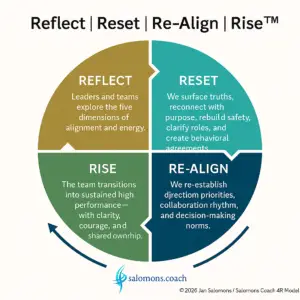New boss? Struggling? Read this!

Insight into why this happens, what psychology and research say about it, and how you can regain control of the situation with practical steps.
There are few workplace situations as emotionally activating as getting a new boss.
Even in stable environments it can feel unsettling. But in high-pressure operational settings like logistics—where daily deadlines, exceptions, and escalations shape the rhythm of the day—the arrival of a new leader can feel like someone has changed the rules of the game overnight.
I coach mainly leaders, so this theme comes by regularly. Some time ago I had a conversation with someone in exactly this situation. Her new manager had only been in the role for two months, but the relationship already felt strained. The previous boss had a more predictable, hands-off style. The new one was direct, detail-focused, culturally different, and constantly present in the operation.
The coachee’s question was simple and honest:
“I have a new boss—and I don’t like him. What should I do?”
If you’ve ever had a similar thought, you’re not alone.
In my own career I’ve had 18 bosses (yes I’m old…), each with their own personality, leadership maturity, cultural lens, and stress triggers. Some inspired me deeply; others taught me what not to do. And some relationships took months—or years—to understand.
This blog offers insight into why this happens, what psychology and research say about it, and how you can regain control of the situation with practical steps.
Why New Bosses Trigger So Much Stress (Psychology & HBR Insights)
1. Your brain reacts to change as a threat
Neuroscience (Rock, 2008; SCARF Model, HBR) shows that unexpected change in hierarchy activates the brain’s threat system. A new boss brings uncertainty in at least five areas:
- Status – Will they see me the same way the old boss did?
- Certainty – What will change? What won’t?
- Autonomy – Will I still have freedom to act?
- Relatedness – Can I trust them?
- Fairness – Will expectations be reasonable?
Your brain perceives a new leader as ambiguity, and ambiguity as risk.
In a VUCA environment, this sensation is magnified.
2. We compare the new boss to the old boss
Humans rely heavily on mental models. When leader A behaves in a familiar way, your mind builds expectations.
Leader B violates those expectations—and the brain interprets this as “wrong,” not “different.”
According to HBR research, employees often experience a dip in engagement and clarity for 6–12 months after a leadership transition—not because the new leader is bad, but because the team unconsciously resists the disruption to established patterns.
3. Cultural differences matter (even inside Western Europe)
We underestimate how different Western European cultures can be:
- Levels of directness
- Comfort with hierarchy
- Pace of decision-making
- Communication style
- Approach to conflict
What looks like “micromanagement” in one culture may feel like “engagement” in another.
What feels “too emotional” in one culture may feel “transparent” in another.
Culture isn’t a problem; mismatch in expectations is.
4. Leaders under pressure behave differently
In operational environments like logistics, leaders often work in constantly elevated stress states.
Daily exceptions. Delays. Customer escalations. Resource shortages.
Many leaders default to their survival patterns:
- control
- speed over reflection
- directive behaviour
- short-term focus
- firefighting
- low patience for nuance
It’s not personal—it’s stress behaviour, not character.
5. Your personality and triggers play a role
A new boss exposes your own patterns too:
- Do you prefer autonomy?
- Do you need structure?
- Do you value stability?
- Do you dislike confrontational styles?
- Do you lean towards perfectionism or harmony?
The friction often reveals more about you than about the new leader.
My Experience With 18 Bosses: The Patterns I’ve Seen
I’ve worked for 18 leaders across Europe, operations, and corporate roles—each shaped by their own culture, pressures, and leadership maturity. Here’s what I’ve observed:
1. The first 90 days are always emotional
Even good leaders disrupt the system.
Even good teams resist change.
2. Conflict usually comes from unmet expectations—not bad intentions
Most friction comes from differences in style, pace, or communication—not capability.
3. The relationship depends on you just as much as on them
The most successful leader–employee relationships I’ve seen came from employees who:
- were proactive in clarifying expectations
- openly shared their working style
- didn’t wait for the boss to “figure them out”
- gave the boss the benefit of the doubt
4. New leaders often feel as insecure as their teams
They inherit an existing culture, a performance backlog, a history they don’t know, and political dynamics they cannot yet see.
I’ve seen new managers lose sleep over whether their team likes or respects them.
5. You always learn something — even from the tough ones
Some of my best leadership lessons came from the bosses I initially disliked:
- how to manage up
- how to communicate under pressure
- how to protect my boundaries
- how to navigate cultural differences
- how to stay calm in chaos
A difficult boss is never just an obstacle—it’s a classroom.
What You Can Do (Practical Actions That Work)
1. Give the relationship 90 days
Research shows it takes 90–180 days for a new leader and team to establish a working rhythm.
Don’t freeze the relationship in a judgment too early.
2. Schedule a “ways of working” conversation
Most friction comes from assumptions.
The cure?
A simple conversation:
“How do you prefer to work? Here’s how I work.”
Topics to discuss:
- decision-making style
- communication style
- feedback preferences
- escalation thresholds
- autonomy vs. involvement
- priorities
- stress triggers
This one conversation can save months of tension.
3. Separate style from intent
Your boss’s style may feel uncomfortable, but their intent might be positive:
- wanting to support
- wanting to understand
- wanting to show ownership
- wanting to improve results
- wanting to build credibility
Look beyond the behaviour—ask what they are trying to achieve.
4. Understand your own triggers
List questions like:
- What exactly bothers me?
- Where have I seen this pattern before?
- Is this about the boss—or about me?
- What assumptions am I making?
- What is this situation teaching me?
This turns frustration into insight.
5. Make their job easier (this always works)
New bosses appreciate people who:
- communicate early
- bring solutions, not only problems
- explain context
- translate data into decisions
- show ownership
This accelerates trust—and trust reduces micromanagement.
6. Talk openly if the relationship gets stuck
Use a non-accusatory framing:
“I want us to work well together. Can we talk about how we can collaborate more effectively?”
Leaders appreciate maturity.
When You Really Don’t Like Your Boss
Sometimes it’s more than style differences:
- They push too hard
- They don’t listen
- They demand unreasonable pace
- They don’t understand the operation
- They act inconsistently
If this happens, the question becomes:
What can you influence?
You can influence:
- your communication
- your boundaries
- your emotional reactions
- the clarity you bring
- the relationship you build
You cannot influence:
- their personality
- their background
- their style
- their stress level
- their past experiences
Let go of what you cannot control.
Focus on what you can.
In Most Cases, the Issue Is Not Liking — It’s Adapting
A new boss creates a transition.
Transitions feel uncomfortable.
Discomfort is not danger.
If there is one truth I’ve learned from working for 18 bosses and coaching hundreds of leaders, it is this:
You don’t have to like your boss immediately.
But you do need to understand them.
Understanding creates clarity.
Clarity builds trust.
Trust enables performance.
And in highly operational environments—where pressure, pace, and deadlines rule—the leader–employee relationship is not a luxury.
The relationship with your manager is the engine of the operation.
Reference List — Leadership Transitions, Psychology, and Managing Up
Here is a reference list of the theories, models, and articles that underpin this blog post. All sources are well-known, widely cited, and aligned with HBR-level academic quality. I use these books/article a lot for my work as coach and leadership development facilitator.
1. David Rock – SCARF Model (Neuroscience of Leadership)
Rock, D. (2008). SCARF: A Brain-Based Model for Collaborating with and Influencing Others.
Harvard Business Review.
(Explains why new bosses trigger threat responses related to Status, Certainty, Autonomy, Relatedness, and Fairness.)
2. HBR – Why Employees Resist Change
Oreg, S., & Sverdlik, N. (2018). What Research Tells Us About How People React to Change.
Harvard Business Review.
(Shows the predictable emotional dip when leadership changes occur.)
3. HBR – Managing Your Boss
Gabarro, J., & Kotter, J. (1993). Managing Your Boss.
Harvard Business Review.
(Major foundation behind proactively shaping the relationship with a new leader.)
4. Michael Watkins – The First 90 Days
Watkins, M. (2013). The First 90 Days: Proven Strategies for Getting Up to Speed Faster and Smarter.
Harvard Business Review Press.
(Relevant for the idea that new leaders and teams need ~90 days to build trust and rhythm.)
5. Erin Meyer – Cultural Dimensions (Western Europe Differences)
Meyer, E. (2014). The Culture Map.
(Powerful framework explaining differences in communication, directness, decision-making, trust, and hierarchy — even inside Western Europe.)
6. Amy Edmondson – Psychological Safety
Edmondson, A. (2018). The Fearless Organization.
(Mostly about team climate, but highly relevant when understanding the discomfort and uncertainty created by a new leader.)
7. William Bridges – Transition Model
Bridges, W. (1991). Managing Transitions: Making the Most of Change.
(Explains emotional reactions to change: Ending → Neutral Zone → New Beginning.)
8. Daniel Kahneman – System 1 & System 2 (Immediate Emotional Judgments)
Kahneman, D. (2011). Thinking, Fast and Slow.
(Shows how quick judgments about a new boss come from fast, emotional processing.)
9. John Kotter – Leading Change (Sense of Loss & Resistance)
Kotter, J. (1996). Leading Change.
(Relevant especially for explaining why people resist change, including leadership transitions.)
10. HBR – How to Work With a New Boss
Boyatzis, R., & McKee, A. (2005). Resonant Leadership.
Paired with HBR articles:
- How to Work with Someone You Don’t Like
- How to Build Trust Quickly With a New Boss
(Useful for developing relational strategies.)
11. VUCA Theory – Leadership in High-Pressure, Fast-Paced Environments
Bennett, N., & Lemoine, G. J. (2014). What VUCA Really Means for You.
Harvard Business Review.
(Relevant for operational environments and the leadership stress patterns you described.)
12. Goleman – Emotional Intelligence Under Pressure
Goleman, D. (1998). Working with Emotional Intelligence.
(Highlights how stress leads to narrowed behaviour, reactivity, and misinterpretations.)
Want to work with me?
If you are dealing with this situation right now, or similar challenges, feel free to book a 30 minutes call (free) to discuss if coaching/mentoring could be a solution for you.
It could remove current blockades for your further development, therefore also be the start of more growth going forward.




